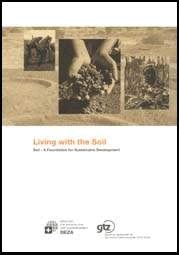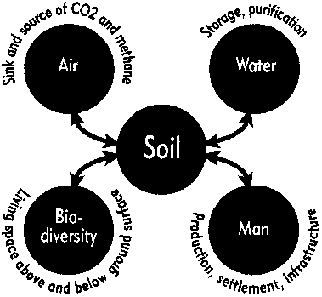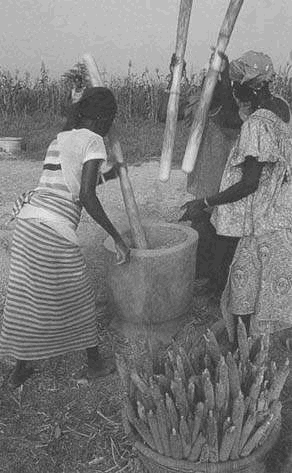
Soil and People - Sharing in Mother Earth[edit | edit source]
Furthermore, soil is the key production factor in crop and animal farming, and forestry, and is thus of supreme economic significance for the predominantly agriculture-based national economies of developing countries.
|
Dirt, soil and mother earth - a substrate for life In physical terms, soil is a mixture of weathered rock, dead plant matter and soil organisms. The mixture of small mineral and organic components also enables water to permeate, and be retained in the pores and in the organic components of a healthy soil. This prevents rapid evaporation, and allows plant roots to absorb moisture slowly. The thin layer of soil covering the earthÂ's land masses thus forms the substrate for all agricultural plant and animal production. |
In most developing countries, 80 to 90% of the population live from agriculture. For them, the soil is the basis of their livelihood, the basis of their day-to-day survival. 1.3 billion people live in poverty, of whom 0.8 million are undernourished. Most of these people live in rural areas, either from a small parcel of land or as farm labourers.
Although we imagine the tropics to be highly fertile, it is the poor, less high-yielding soils which predominate. The shortage of land forces many farmers to farm steep slopes, or cultivate fields in dry savannah zones with low and irregular precipitation. The rural poor in particular are forced onto the worst sites. Sustainable rural development and poverty reduction are thus also soil-related issues.
In the sub-Saharan African countries, agriculture ultimately absorbs around three-quarters of the working population. It accounts for 40% of the GDP of the low-income countries. For half of these countries, it generates on average 60% of export revenues: Soil is thus a key factor in national economies.
And a key factor in the nutrition of the worldÂ's continuously expanding population. In 2025 the world will be inhabited by an anticipated 8 billion people. Food production will therefore need to expand by 40%. But even then, not all mouths will be properly fed. Because today, many people are already undernourished. Consequently, the increase in production would need to be even larger. Food security remains one of the major challenges faced by humanity.
The multiple functions of the soil
Figure
|
Tanzania: Soil Erosion Control and Agroforestry Project, SECAP In the Usambara mountains of Tanzania, a healthy climate and fertile soils have led to a very high population density. This has led to increased utilisation, as well as exploitation, of soil resources. The negative results are increasing soil erosion, declining soil fertility and thus the destruction of the natural resource base on which hundreds of thousands of people are vitally dependent. Objectives and methods The aim of this GTZ-supported project is to introduce participatory methods to control erosion and promote soil fertility. Since 1993, a so-called Â"catchment approachÂ" has been tested in several small watersheds. The catchment approach involves planning the control measures for the entire watershed with the participation of all riparians. Once the approach had been developed to practice-readiness and the extension workers correspondingly trained, the approach was implemented. By June 1998 it was being applied in 54 watersheds. Joint initial planning, annual definition of planning targets and binding agreement on the inputs to be provided by all riparians proved successful. Interventions The measures are implemented at three levels. At the farm level, work teams construct terraces and protective strips, and plant trees, on a mutual neighbourhood help basis. As a result, the soil absorbs more water. The water no longer runs off the surface, carrying soil with it. Consequently, more water is available to plants, and the compost, dung or mineral fertiliser applied is no longer washed away by the rain. Yields increase, and also become more secure. At the village level the project promotes the formation of self-help groups, including womenÂ's groups. Schools are supported in incorporating the themes of natural resource protection and sustainable soil management into the curricula. At the district level, the staff of agricultural and forest services receive training in modern extension methods. The project supports the district committee for natural resources in planning natural resource management measures. |

